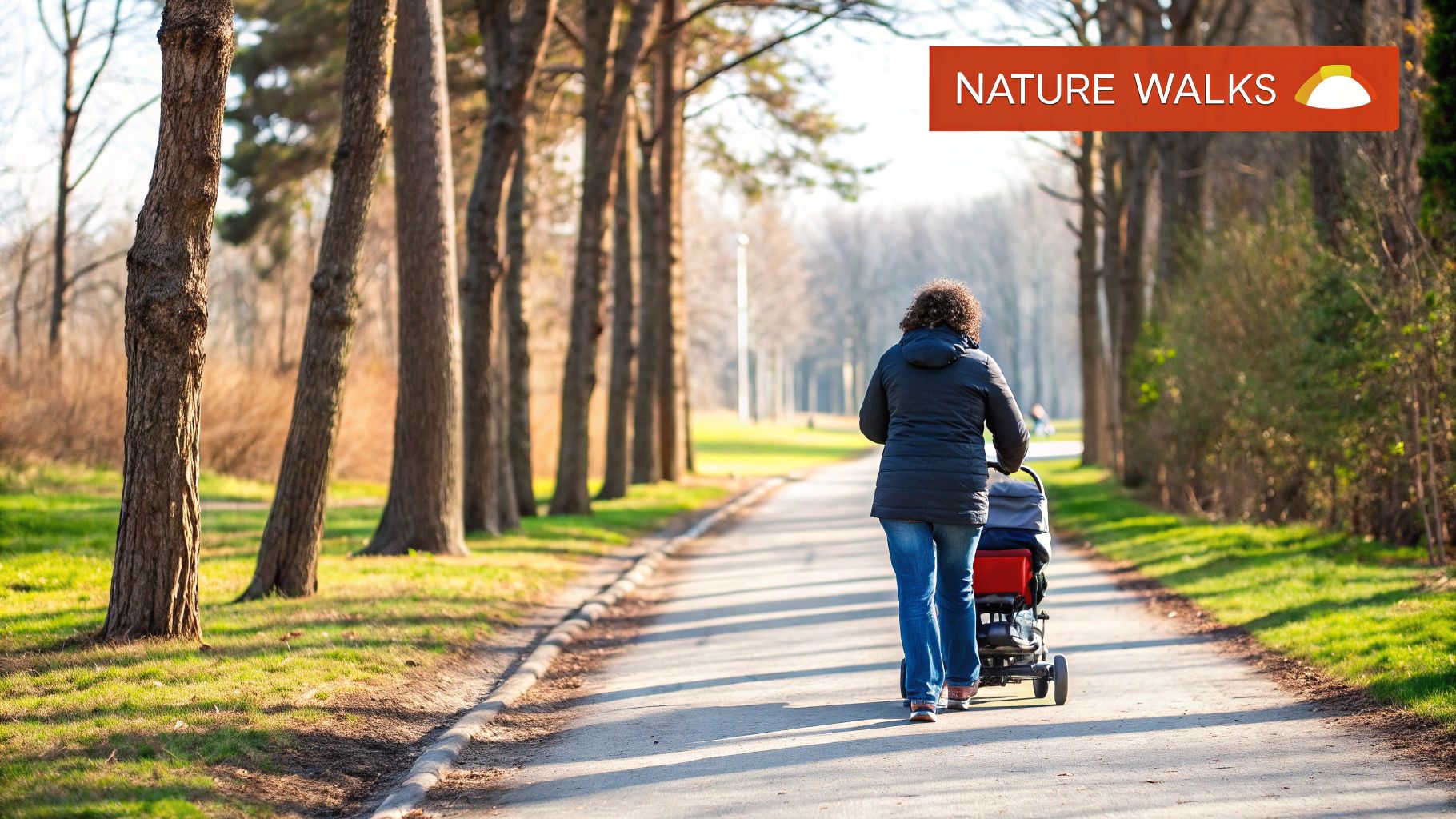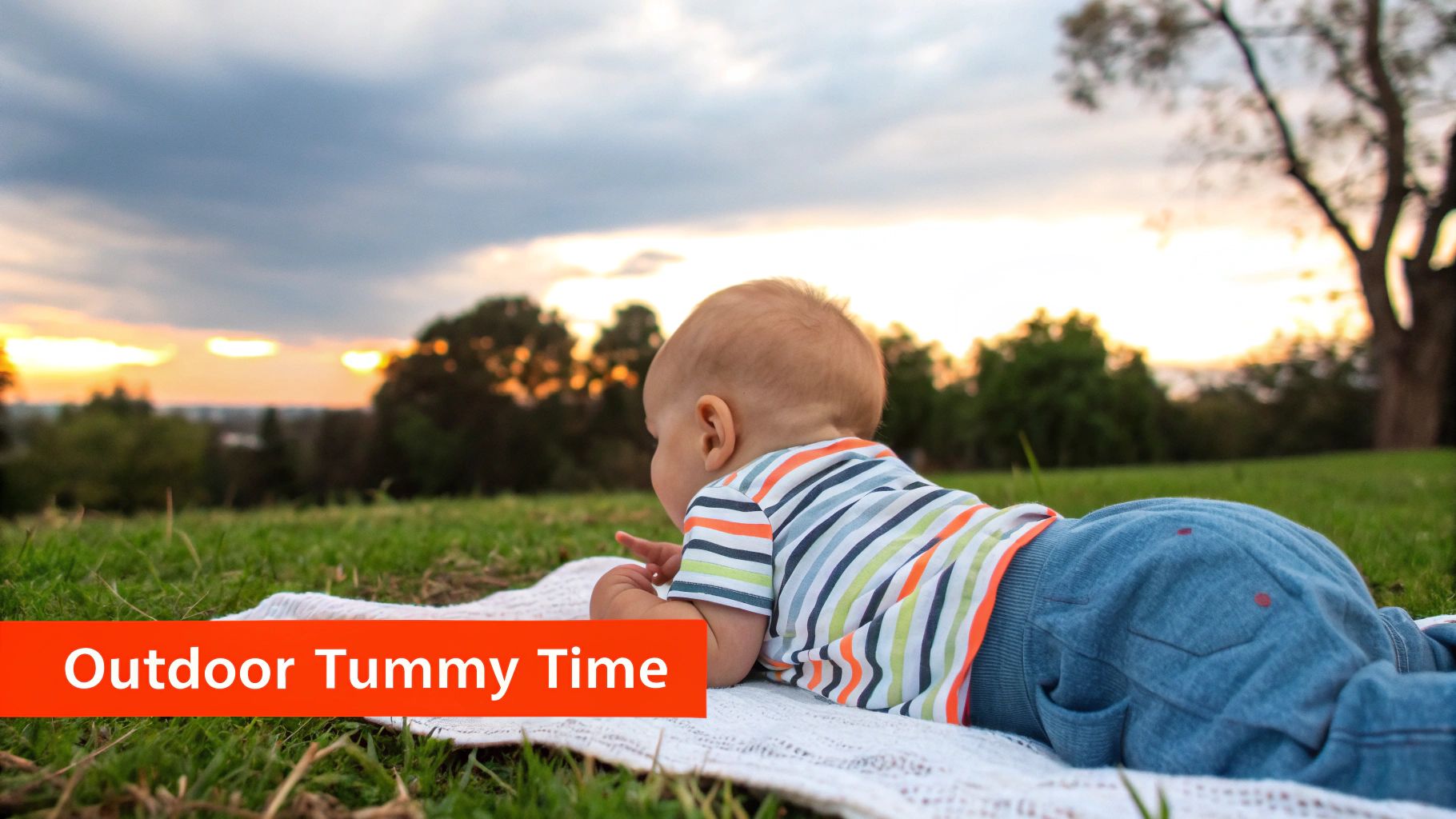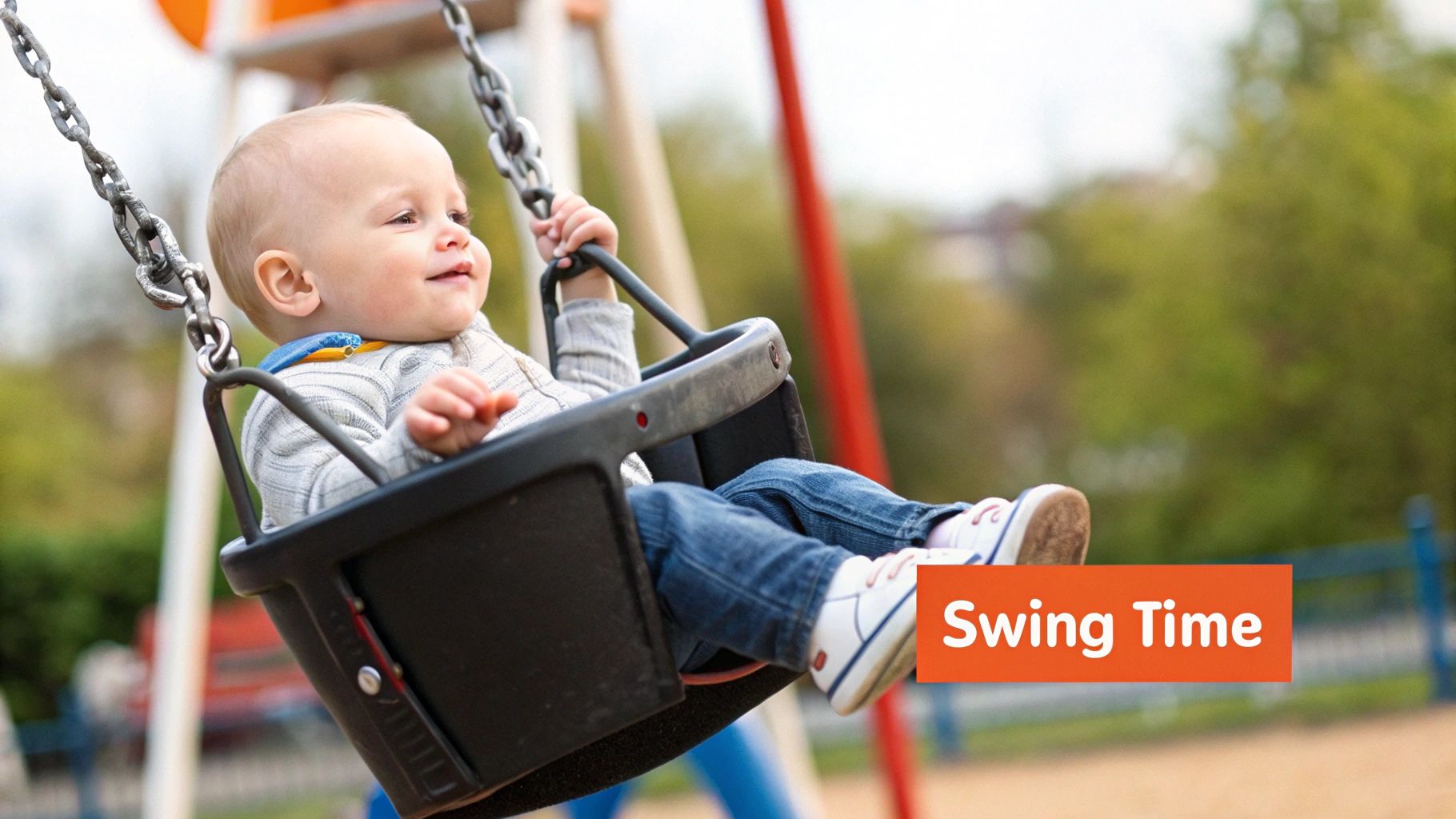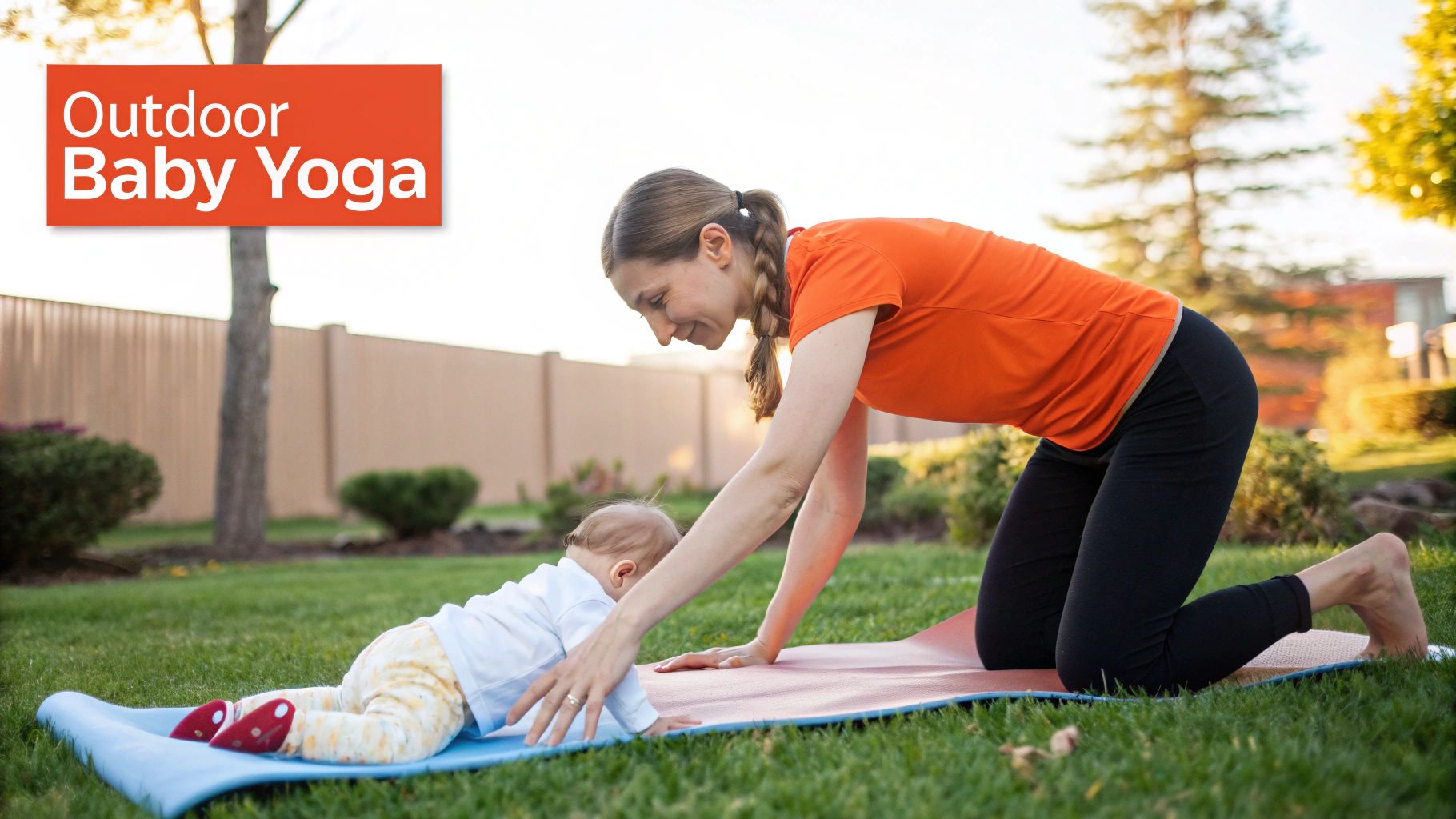
6 Essential Developmental Outdoor Activities for Infants
Venturing outdoors with your infant can feel like a big step, but the rewards for their development and your well-being are immeasurable. Exposing your baby to the rich tapestry of sights, sounds, and textures of the natural world is more than just a breath of fresh air; it's a foundational experience that stimulates brain growth, regulates sleep cycles, and builds a lifelong connection with nature.
This guide moves beyond generic advice to provide a detailed, educational roadmap for safe and beneficial outdoor activities for infants. We will explore six distinct, age-appropriate experiences, from sensory nature walks to gentle water play, each packed with actionable tips on preparation, safety, and specific developmental benefits.
Our goal is to empower you with the confidence and practical knowledge needed to make the outdoors your baby's favorite classroom. You will learn not just what to do, but why it is so beneficial for their cognitive and physical growth, fostering your infant's curiosity and creating cherished memories from their very first months. Let's dive into the activities that will enrich your baby's world.
1. Nature Walks in Baby Carriers or Strollers
Nature walks are one of the most accessible and foundational outdoor activities for infants. By securing your baby in an ergonomic carrier or a sturdy stroller, you can introduce them to the sights, sounds, and sensations of the natural world in a safe and supportive manner. This simple activity supports sensory integration, promotes calmness through rhythmic motion, and offers a gentle way to establish a daily routine that benefits both caregiver and child.
From the gentle rustling of leaves to the warmth of filtered sunlight, a walk through a park or down a quiet trail provides a rich tapestry of sensory input. This exposure is crucial for neural development, helping your baby's brain form new connections as they process the world around them.

Why This Activity is Essential for Development
This activity is more than just a walk; it’s a tool for early sensory and emotional development. Pediatricians like Dr. Harvey Karp often recommend outdoor time as part of a "fourth trimester" routine to soothe newborns. The rhythmic motion of walking can be incredibly calming, often lulling babies to sleep while providing parents with much-needed fresh air and light exercise.
Organizations like Hike it Baby, which has facilitated over 50,000 family walks globally, demonstrate the power of community in making outdoor activities for infants a regular habit. Similarly, brands such as Ergobaby and UPPAbaby have engineered products specifically designed to make these excursions more comfortable and practical for families, supporting proper hip and spine alignment.
How to Get Started
Implementing nature walks into your routine is straightforward. The key is to start small and prioritize comfort and safety to maximize the developmental benefits.
- Start Short and Simple: Begin with 10 to 15-minute walks in your neighborhood or a local park. As you and your baby get more comfortable, you can gradually increase the duration.
- Choose the Right Path: Opt for smooth, even surfaces like paved park paths or well-maintained trails to minimize jostling, especially for younger infants. Many national and state parks now offer stroller-friendly trails designed for families.
- Time It Right: Schedule walks during cooler parts of the day in summer or during the "golden hours" of early morning or late afternoon for gentle, less direct sunlight.
- Dress in Layers: A baby’s ability to regulate their temperature is still developing. Dressing them in layers allows you to easily add or remove clothing. A good rule is to dress your baby in one more layer than you are wearing. Always check their temperature by feeling the back of their neck or chest.
By integrating these walks into your life, you are not just enjoying an outing; you are laying a foundation for a lifelong appreciation of the outdoors and providing critical developmental stimulation for your infant.
2. Tummy Time on Outdoor Blankets
Taking the essential developmental exercise of tummy time outdoors introduces a new layer of sensory exploration for your infant. By spreading a clean blanket or play mat in a safe, shaded area, you combine a crucial muscle-building activity with the rich stimuli of the natural world. This simple practice allows your baby to strengthen their neck, shoulder, and core muscles while feeling a gentle breeze, watching leaves dance, and hearing the sounds of nature.

Why This Activity is Essential for Development
Outdoor tummy time transforms a necessary routine into an engaging sensory experience that accelerates motor development. The varied textures of grass or a blanket, combined with the sights and sounds of the outdoors, motivate babies to lift their heads, push up, and look around. This multi-sensory engagement can make tummy time more enjoyable and effective, encouraging longer and more frequent sessions that build gross motor skills.
The benefits are widely recognized by developmental experts. Organizations like Pathways.org promote tummy time as a critical component of preventing motor delays, and the American Academy of Pediatrics' "Back to Sleep, Tummy to Play" campaign underscores its importance. Furthermore, RIE educators like Janet Lansbury advocate for outdoor play from infancy, highlighting its role in fostering independent exploration and physical confidence.
How to Get Started
Introducing outdoor tummy time is simple with the right preparation. Focus on creating a safe, comfortable, and stimulating environment to maximize the developmental benefits.
- Choose a Safe Spot: Find a clean, flat, and shaded area, preferably on soft grass. Always check the ground for hazards like sharp objects or insects before laying down your blanket.
- Time It for Comfort: Schedule sessions before a feeding to minimize spit-up and avoid the peak sun hours of 10 a.m. to 4 p.m. Also, check that the ground temperature is comfortable to your touch.
- Start Slowly: Begin with just 2 to 3 minutes of tummy time, several times a day. As your baby's strength and tolerance grow, you can gradually extend the duration of these outdoor activities for infants.
- Engage Their Senses: Lie down at eye level with your baby to talk and interact with them. Place high-contrast toys or natural objects like large, smooth leaves just within their sightline to encourage head-lifting. To find toys that can help keep your baby engaged, explore Montessori-inspired tummy time mirrors on miniprecious.com.
By moving this vital activity outdoors, you provide your infant with a powerful combination of physical development and sensory enrichment, setting a positive foundation for their growth and exploration.
3. Infant Swinging in Baby Swings
Gentle swinging in a secure, age-appropriate baby swing is a delightful and developmentally rich outdoor activity. Using a swing specifically designed with safety harnesses and full-body support, you can introduce your infant to the joy of rhythmic motion. This activity engages their vestibular system, which is crucial for developing balance and spatial awareness, all while they observe the outdoor world from a unique, elevated perspective.
The calming, repetitive motion is not just enjoyable; it’s a powerful tool for sensory regulation. For many babies, the gentle back-and-forth movement is incredibly soothing, helping them process their surroundings without becoming overwhelmed. This makes swinging one of the most beneficial outdoor activities for infants who are ready for more dynamic sensory experiences.

Why This Activity is Essential for Development
Swinging offers more than just fun; it's a foundational experience for an infant's sensory and motor development. Occupational therapists often recommend vestibular activities like swinging to help infants build core strength, improve head control, and understand their body's position in space. The gentle stimulation helps organize the nervous system, which can lead to better sleep and a calmer disposition.
Brands like Fisher-Price and Little Tikes have created iconic outdoor infant swings that have been staples in backyards for generations. Additionally, the increasing inclusion of fully-enclosed or ADA-compliant infant bucket swings in public parks, a trend long popular in European playgrounds, has made this activity more accessible than ever. This focus on safety and developmental appropriateness underscores the value experts place on swinging.
How to Get Started
Introducing your infant to swinging requires careful attention to their readiness and comfort. Safety and moderation are the pillars of a positive experience.
- Wait for Head Control: Before using a swing, ensure your baby has consistent and strong head and neck control. This is a critical safety milestone.
- Start Gentle and Short: Begin with very slow, gentle pushes for just 5 to 10 minutes. Always push from the front so your baby can see your reassuring face, which helps them feel secure.
- Prioritize Safety Checks: Whether in your yard or at a park, always inspect the swing. Check for intact straps, a stable installation, and no sharp or broken parts. At public playgrounds, it’s a good idea to wipe down the seat before use.
- Observe Your Baby's Cues: Pay close attention to signs of overstimulation, such as fussiness, arching their back, or looking away. If they seem uncomfortable, it's time to stop. Also, avoid swinging immediately after a feeding to prevent an upset stomach.
By incorporating short, gentle swinging sessions into your outdoor time, you provide your baby with a joyful activity that actively supports their sensory integration and physical development, strengthening their connection to the world around them.
4. Baby Water Play and Splash Activities
Supervised water play introduces infants to a new and exciting sensory environment, offering a delightful way to stay cool on warm days. Activities like dipping toes in a shallow wading pool or sitting on a gentle splash pad stimulate tactile senses and support motor skill development. This gentle introduction to water builds comfort and confidence, turning a simple outdoor activity into a powerful learning experience.
The sensation of cool water, the sound of splashing, and the sight of shimmering ripples provide a unique form of sensory input distinct from land-based play. This exposure is not only fun but also beneficial for cognitive growth, helping your baby understand concepts like cause and effect as they pat the water and see it move.

Why This Activity is Essential for Development
Water play is more than just a method to cool off; it’s a significant developmental tool. The American Academy of Pediatrics highlights that sensory play helps build nerve connections in the brain's pathways. Water provides a safe and engaging medium for this, encouraging kicking, splashing, and reaching, which strengthens muscles and improves coordination.
Organizations like Infant Swimming Resource (ISR) promote early water acclimation as a foundation for future water safety skills. Meanwhile, companies such as Step2 and Little Tikes design water tables specifically for infants and toddlers to encourage standing and fine motor practice. The increasing availability of infant-appropriate features at municipal splash pads shows a growing recognition of the value of these outdoor activities for infants.
How to Get Started
Introducing your baby to water play requires a focus on safety and gradual exposure. Creating a positive and secure environment is key to a successful experience.
- Prioritize Constant Supervision: Never leave an infant unattended near any amount of water, even for a second. An adult should always be within arm's reach.
- Keep it Shallow and Warm: For babies who can sit independently, water in a kiddie pool should be no more than 2-3 inches deep. The water temperature should be comfortably lukewarm, around 85-90°F.
- Time It for Comfort: Limit initial sessions to 10-15 minutes to prevent chilling or overstimulation. Watch for signs of being cold, like shivering or blueish lips, and end the session immediately if they appear. You can find excellent options for backyard fun with products like this non-slip splash pad.
- Protect Their Skin: Apply a waterproof, baby-safe sunscreen 15-30 minutes before heading outside. Use sun-protective swimwear with a UPF 50+ rating and a wide-brimmed hat to shield your baby from harmful UV rays. Always have a warm towel ready for when playtime is over.
By following these safety-conscious steps, you can provide your baby with a wonderful sensory adventure that supports their development and creates happy summer memories.
5. Sensory Nature Exploration and Outdoor Touch Baskets
Sensory nature exploration invites your infant to discover the world through their most powerful learning tool: their sense of touch. By creating a curated "touch basket" or a designated exploration area on a blanket, you can offer a safe, supervised environment for your baby to engage with the textures, smells, and sights of natural objects. This activity is a cornerstone of early cognitive development, fostering curiosity and building foundational neural pathways.
From the rough texture of a pinecone to the smoothness of a river stone, each object provides a unique sensory input. This hands-on interaction helps infants understand concepts like hard, soft, rough, and smooth, laying the groundwork for scientific thinking and vocabulary development as you describe what they are feeling.
Why This Activity is Essential for Development
This is more than just playtime; it's a profound developmental experience. The concept was popularized by pioneers like educator Elinor Goldschmied, who developed the "treasure basket" to promote concentration and choice-making in pre-mobile infants. Similarly, the Reggio Emilia approach and various Forest School movements heavily emphasize the use of natural materials for authentic learning.
Engaging with a diverse range of natural textures supports sensory processing and fine motor skill development. As babies grasp, mouth, and manipulate objects, they are strengthening the small muscles in their hands and improving hand-eye coordination. This simple yet effective activity provides a rich, multi-sensory foundation that is crucial for brain development.
How to Get Started
Creating a safe and engaging sensory experience is simple with the right preparation. The focus is on careful selection and constant supervision.
- Gather Nature's Treasures: Collect safe, non-toxic items from your yard or a park. Think large, smooth stones, pieces of bark, pinecones, sturdy leaves, and non-poisonous flowers.
- Prioritize Safety: The most important rule is to choose items that are too large to be a choking hazard. A good guideline is to only use objects that are bigger than the opening of a toilet paper tube. Always wash items thoroughly before giving them to your baby.
- Create an Invitation to Play: Arrange the items in a shallow, wide basket or spread them out on a soft blanket. This creates a "yes space" where your baby is free to explore everything within reach without restriction.
- Supervise and Narrate: This is an activity for you to do together. Stay within arm's reach at all times, as your baby will naturally want to mouth the objects. Narrate their experience by saying things like, "That's a rough piece of bark," or "You found a smooth, cool rock," to build their vocabulary.
By setting up these simple sensory sessions, you are not just offering one of the most enriching outdoor activities for infants; you are fostering a deep, sensory-based connection to the natural world.
6. Outdoor Infant Yoga and Movement
Outdoor infant yoga and movement combines gentle, guided stretches with the sensory richness of a natural setting. By performing simple, yoga-inspired poses and massages on a soft blanket under the open sky, you can promote your baby’s flexibility, body awareness, and relaxation. This mindful practice leverages the calming atmosphere of nature to deepen the bond between caregiver and child, creating a peaceful and nurturing experience.
The core of this activity is responsive, gentle motion. From mimicking the swaying of trees with a gentle rock to performing "bicycle legs" while listening to birdsong, outdoor yoga provides multi-sensory stimulation. This engagement supports motor skills, helps relieve gas and colic, and introduces your infant to movement in a supportive, stress-free environment.
Why This Activity is Essential for Development
This is more than just stretching; it's a form of communication and a tool for developmental support. The practice of infant yoga and massage was pioneered by figures like Helen Garabedian of Itsy Bitsy Yoga and Vimala McClure, who founded the International Association of Infant Massage. Their work highlights how purposeful touch and movement can improve an infant's sleep patterns, aid digestion, and enhance neuromuscular development.
Practicing outdoors adds another layer of benefits. The fresh air, natural light, and ambient sounds can significantly reduce stress for both parent and baby. Many postpartum fitness programs and baby-and-me classes, such as those inspired by the Birthlight method, now offer outdoor sessions to harness these dual benefits of mindful movement and nature therapy, making it one of the most enriching outdoor activities for infants.
How to Get Started
Introducing outdoor yoga is simple and requires minimal equipment. The focus should always be on your baby’s comfort, cues, and safety.
- Find a Serene Spot: Choose a quiet, shaded area in a park or your backyard. Lay down a soft blanket or a yoga mat on a flat, grassy surface free of debris.
- Time It for Contentment: The best time for this activity is when your baby is calm, alert, and well-rested, often between naps. Avoid practicing right after a feeding; wait at least 30 minutes.
- Follow Your Baby’s Lead: Keep sessions short, around 10 to 15 minutes. Pay close attention to your baby’s cues. If they seem fussy or resistant, it’s best to stop and try again later. Never force a movement or stretch.
- Learn Basic, Safe Poses: Start with simple movements. Gently cycle their legs, bring their knees to their chest, and perform gentle, supported stretches. Always support your baby's head and neck. Consider watching tutorials from reputable sources like Cosmic Kids Yoga or taking a local class to learn proper techniques.
Outdoor Infant Activities Comparison
| Activity | Implementation Complexity 🔄 | Resource Requirements ⚡ | Key Developmental Benefits 📊 | Ideal Use Cases 💡 | Key Advantages ⭐ |
|---|---|---|---|---|---|
| Nature Walks in Baby Carriers or Strollers | Low - requires stroller/carrier and weather prep | Moderate - ergonomic carrier/stroller investment | Sensory integration, vestibular development, sleep regulation | Daily routines, all infant ages (0-12 months), varied terrains | Minimal equipment, promotes bonding, exercise for caregivers |
| Tummy Time on Outdoor Blankets | Low - simple setup with blanket and supervision | Very low - blanket or mat only | Gross motor skills (neck, core strength), sensory input | Safe outdoor spaces, newborn to 6 months, supervised floor time | Cost-effective, enhances engagement in tummy time |
| Infant Swinging in Baby Swings | Moderate - requires proper swing and supervision | Moderate - access to safe swing and playground | Vestibular stimulation, balance, visual tracking | Infants 6-12 months with head control, playground visits | Calming effect, free access at many playgrounds |
| Baby Water Play and Splash Activities | Moderate - supervision critical, water management | Moderate - splash pads, pools, or simple water bowls | Tactile exploration, gross motor skills, cause-and-effect learning | Warm weather, infants 3+ months, backyard or splash pads | Engaging sensory play, builds water confidence |
| Sensory Nature Exploration and Outdoor Touch Baskets | Moderate - item selection and supervision required | Very low - natural materials from environment | Sensory processing, cognitive development, fine motor skills | Independent sitting infants (6-12 months), heuristic play | Free materials, rich sensory and cognitive benefits |
| Outdoor Infant Yoga and Movement | Moderate - requires learning techniques and supervision | Low - comfortable surface (mat/blanket) | Flexibility, body awareness, bonding, relaxation | Any outdoor space, infants 0-12 months with modifications | Enhances bonding, supports digestion and sleep |
Making Outdoor Adventures a Joyful Part of Your Routine
Integrating outdoor time into your baby’s schedule is one of the most rewarding and beneficial ways to support their growth. As we've explored, the benefits extend far beyond a simple change of scenery. From the gentle rhythm of a nature walk that develops their vestibular system to the rich sensory input of a touch basket that builds neural connections, these experiences are foundational. They are the building blocks for cognitive development, motor skills, and a robust immune system.
The key to success isn't about planning elaborate excursions. Instead, it’s about embracing small, consistent moments of learning. A ten-minute session of tummy time on a soft blanket in the backyard, listening to birdsong and feeling a gentle breeze, can be just as impactful as a trip to a state park. Remember, the goal is to make nature an accessible and enjoyable part of their education, not another task on your to-do list.
Key Takeaways for Your Outdoor Journey
Let's distill the core principles for maximizing the developmental benefits of outdoor time:
- Follow Your Baby’s Lead: Your infant is your most reliable guide. Pay close attention to their cues for hunger, fatigue, or overstimulation. A successful outing is one that respects their pace and comfort.
- Safety First, Always: Preparation is paramount. A well-stocked diaper bag with sun protection, appropriate layers of clothing, and hydration ensures you can handle whatever the adventure brings, allowing you to relax and be present.
- Engage the Senses: The outdoors is a symphony of stimuli. Actively encourage sensory exploration by describing what you see, letting your baby safely touch different textures, and simply being still enough to hear the sounds of nature. These moments are crucial for brain development.
Mastering these simple approaches transforms outdoor activities for infants from a daunting task into a joyful, enriching routine. By prioritizing flexibility and preparation, you create a positive feedback loop. Your baby learns that the outdoors is a safe and fascinating place, and you gain confidence in providing them with these vital developmental experiences.
You are not just taking your baby outside; you are laying the groundwork for a lifetime of curiosity, resilience, and a deep appreciation for the natural world. These early adventures, from the first time their toes touch cool grass to their delighted giggle in a baby swing, are precious memories in the making. They strengthen the incredible bond you share, creating a shared history of discovery and wonder. Embrace the simplicity, cherish the moments, and watch your little one blossom in the great outdoors.
Ready to make your outdoor adventures even more comfortable and stylish? For premium, soft, and breathable baby essentials perfect for any outing, explore the collection at MiniPrecious. Their thoughtfully designed products ensure your little one stays cozy, whether you're on a nature walk or enjoying a picnic in the park. MiniPrecious

